Franchise Agreement Samples
-
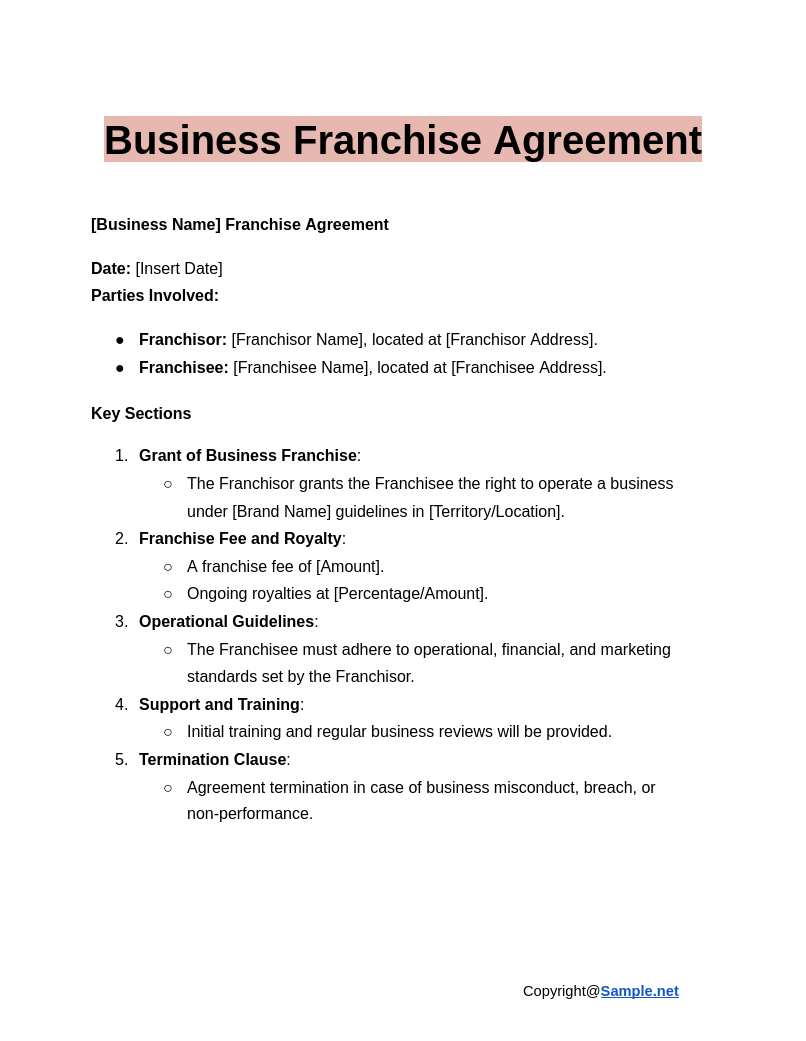
Business Franchise Agreement
download now -
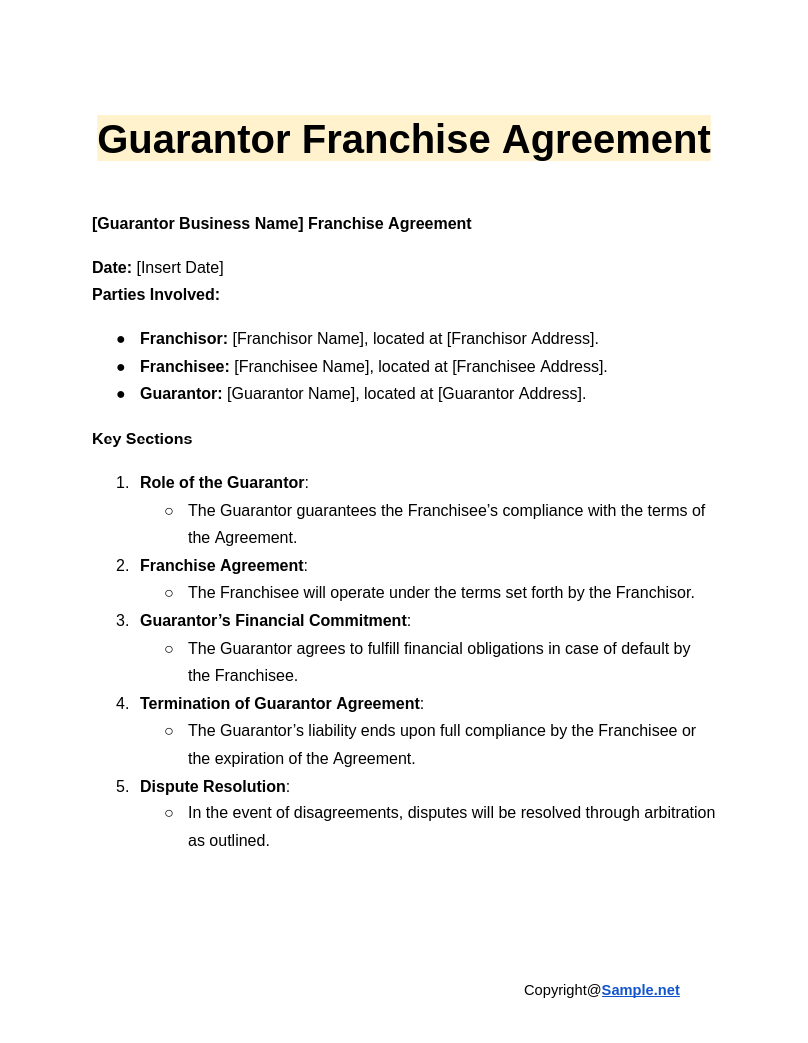
Guarantor Franchise Agreement
download now -

Gym Franchise Agreement
download now -
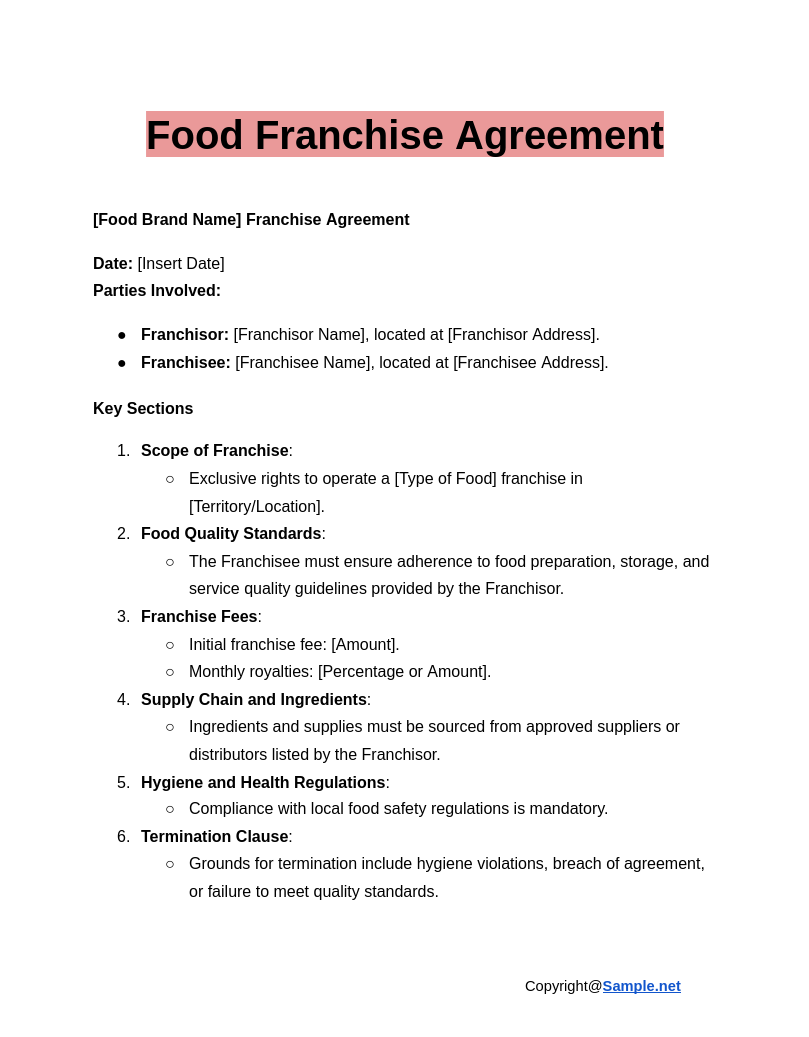
Food Franchise Agreement
download now -
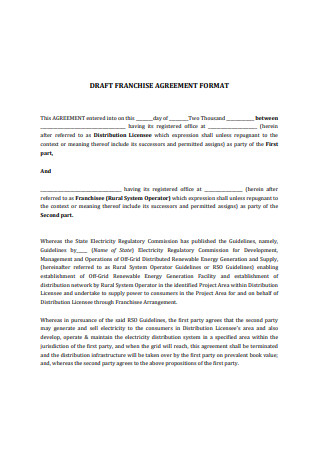
FREE Franchise Agreement s to Download
Franchise Agreement Format
Franchise Agreement Samples
What is a Franchise Agreement?
Elements of a Franchise Agreement
How to Make a Franchise Agreement
FAQS
What happens if a franchisee breaches the agreement?
How does a Franchise Agreement protect intellectual property?
What are the key financial obligations in a Franchise Agreement?
What should a franchisee review before signing the agreement?
What is territorial exclusivity in a Franchise Agreement?
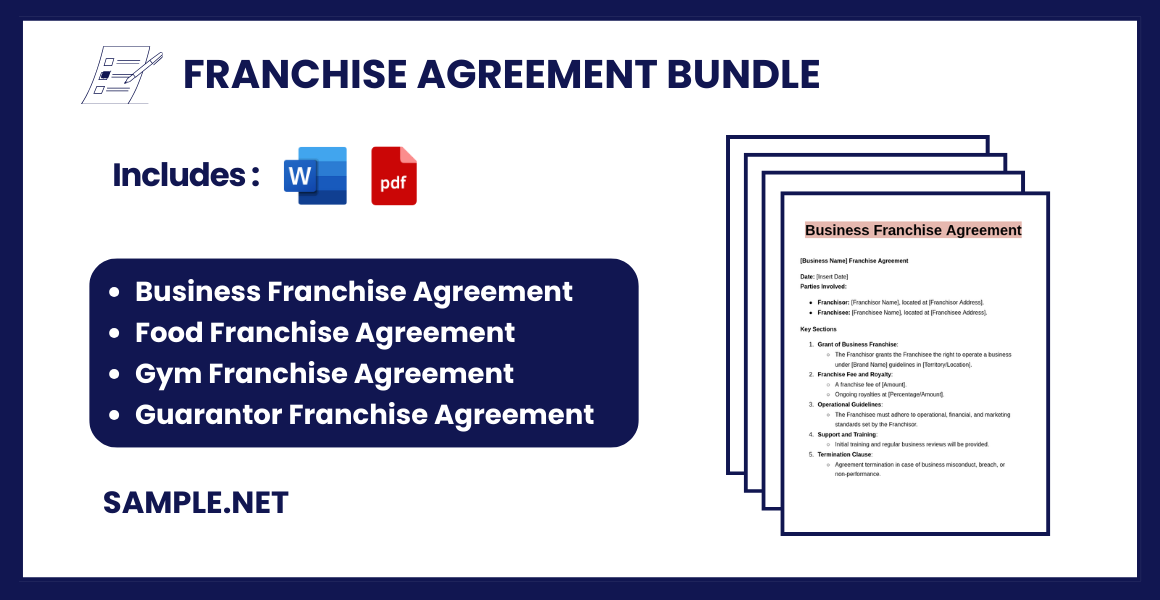
Download Franchise Agreement Bundle
Franchise Agreement Format
This Franchise Agreement (the “Agreement”) is made and entered into on this [Date] by and between:
Franchisor: [Franchisor Name], having its principal office at [Franchisor Address].
Franchisee: [Franchisee Name], residing or located at [Franchisee Address].Collectively referred to as the “Parties.”
1. Recitals
1.1 The Franchisor owns the trademark, business model, and system known as [Brand Name].
1.2 The Franchisee desires to obtain a franchise to operate under the Franchisor’s system.
1.3 The Franchisor agrees to grant the Franchisee the right to operate the franchise, subject to the terms of this Agreement.2. Grant of Franchise
2.1 The Franchisor grants the Franchisee the right to operate a franchise under the [Brand Name] trademark at [Location].
2.2 This Agreement is non-transferable except as provided herein.3. Term and Renewal
3.1 The term of this Agreement shall be for a period of [Number of Years] years from the date of execution.
3.2 The Franchisee may renew the Agreement subject to the renewal terms set by the Franchisor.4. Franchise Fee and Royalty
4.1 The Franchisee shall pay a one-time franchise fee of [Amount].
4.2 The Franchisee shall pay a royalty fee of [Percentage or Amount], calculated on gross sales, payable [Monthly/Quarterly].5. Obligations of the Franchisor
5.1 Provide the Franchisee with training and operational guidelines.
5.2 Ensure consistent supply of products and services necessary for business operation.
5.3 Offer ongoing support, including marketing and promotional strategies.6. Obligations of the Franchisee
6.1 Operate the franchise strictly following the Franchisor’s guidelines.
6.2 Maintain quality standards as prescribed by the Franchisor.
6.3 Avoid engaging in competing or similar businesses during the term of this Agreement.7. Intellectual Property
7.1 The Franchisee acknowledges the Franchisor’s exclusive ownership of trademarks, logos, and business systems.
7.2 The Franchisee agrees not to use the trademarks outside the scope of this Agreement.8. Confidentiality
8.1 The Franchisee shall not disclose or misuse any confidential information or trade secrets obtained through the Agreement.
9. Termination
9.1 The Franchisor may terminate this Agreement if the Franchisee:
- Breaches the terms of this Agreement.
- Fails to meet performance standards.
- Engages in actions harmful to the Franchisor’s reputation.
9.2 Upon termination, the Franchisee shall cease all operations and return all proprietary materials to the Franchisor.
10. Indemnification
The Franchisee agrees to indemnify and hold harmless the Franchisor against all liabilities arising out of the operation of the franchise.
11. Dispute Resolution
11.1 Any disputes shall be resolved through arbitration, conducted in [City/State], under the rules of [Arbitration Organization].
12. Governing Law
This Agreement shall be governed by and construed in accordance with the laws of [State/Country].
13. Entire Agreement
This Agreement constitutes the entire understanding between the Parties and supersedes all prior agreements.
14. Notices
All notices shall be sent to the addresses mentioned above or updated by the Parties in writing.
Signatures
Franchisor:
[Name]
[Signature]
[Date]Franchisee:
[Name]
[Signature]
[Date]
Draft Franchise Agreement Format
download now -
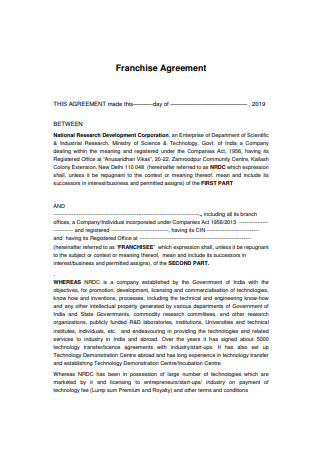
Franchise Agreement
download now -
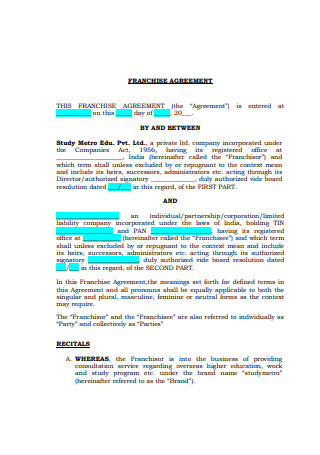
Franchise Agreement Sample
download now -

Franchise Agreement Example
download now -
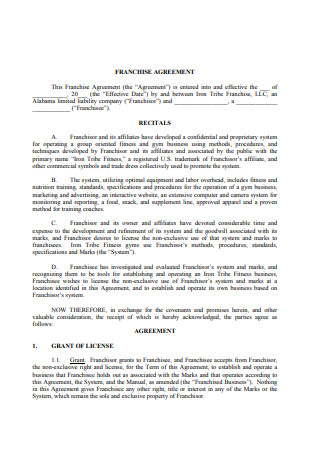
Basic Franchise Agreement
download now -
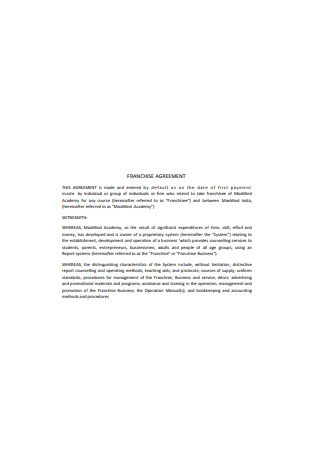
Franchise Agreement in PDF
download now -
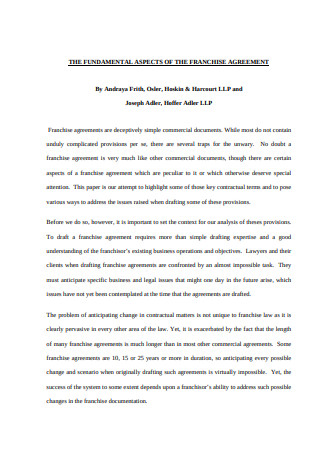
Fundamental Aspects of the Franchise Agreement
download now -

Franchise Agreement Checklist
download now -
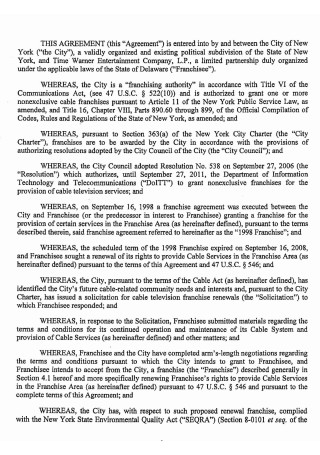
Cable Franchise Agreement
download now -
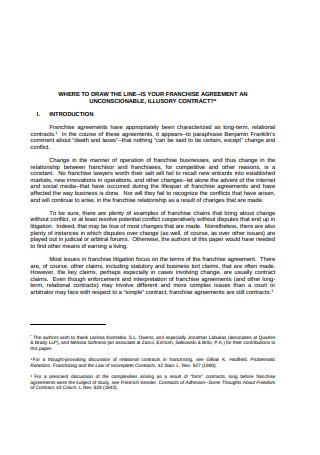
Basic Franchise Agreement Sample
download now -
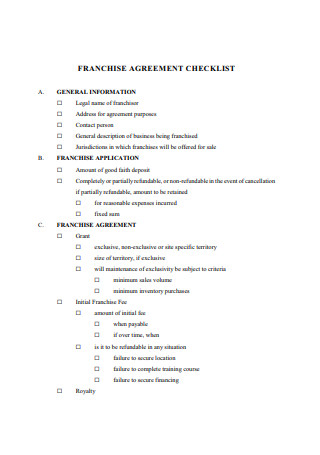
Sample Franchise Agreement Checklist
download now -
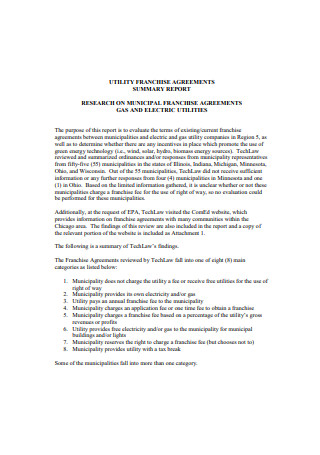
Franchise Agreement Summary Report
download now -
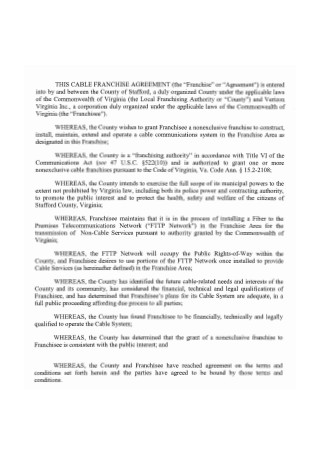
Cable Franchise Agreement Sample
download now -
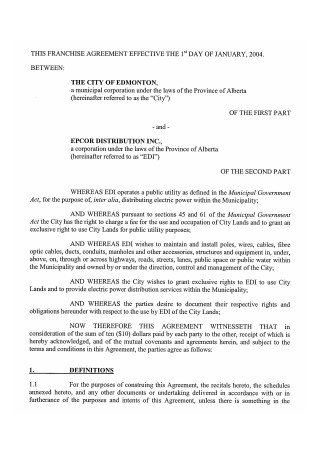
Franchise Agreement Bylaw
download now -
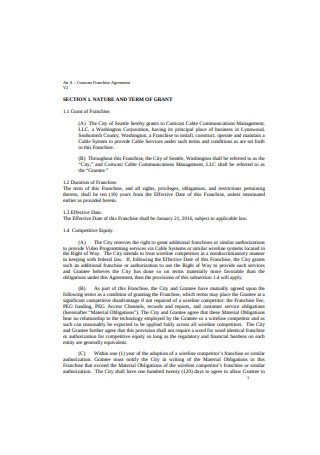
Simple Franchise Agreement
download now -

Non-Exclusive Franchise Agreement
download now -
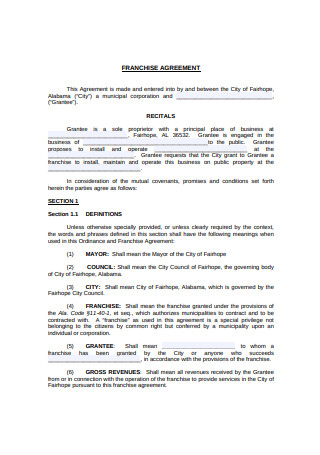
Standard Franchise Agreement
download now -
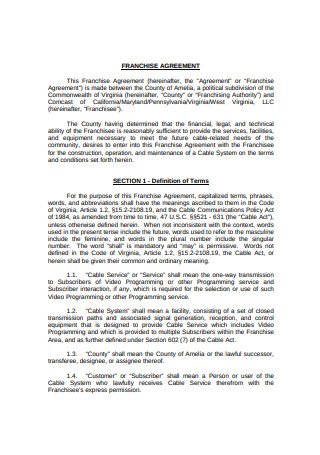
Simple Franchise Agreement Example
download now -

Printable Franchise Agreement
download now -
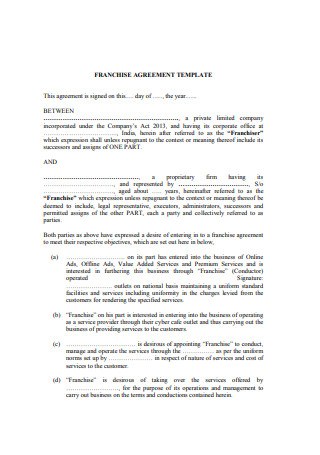
Franchise Agreement Template
download now -
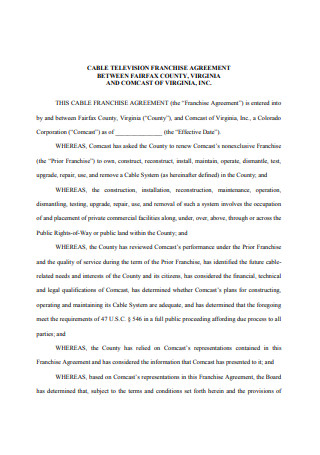
Cable Television Franchise Agreement
download now -
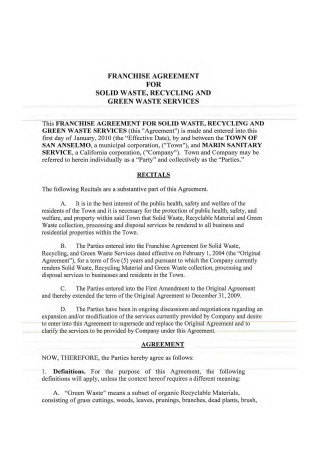
Sample Franchise Agreement Example
download now -
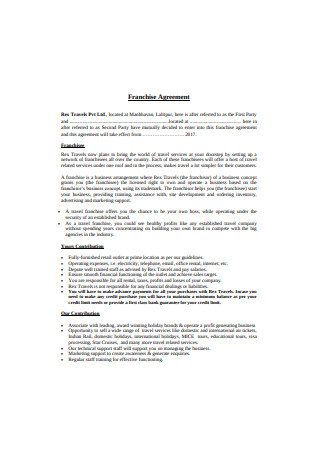
Simple Franchise Agreement Format
download now -
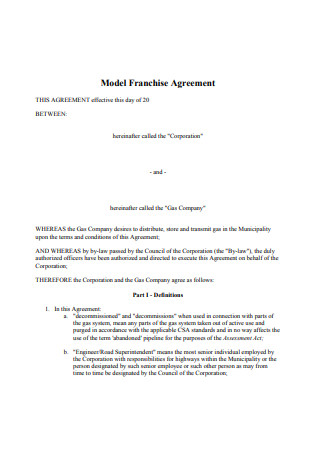
Model Franchise Agreement
download now -
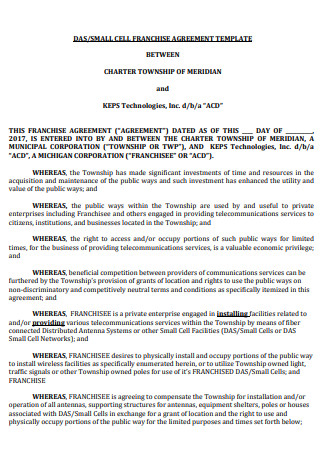
Small Cell Franchise Agreement
download now -
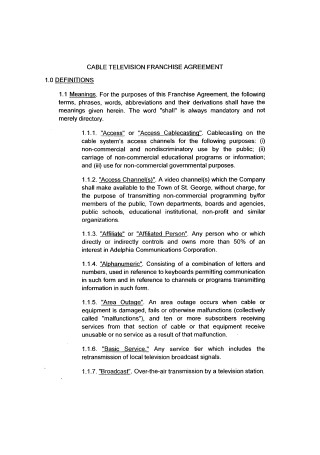
Cable Television Franchise Agreement Sample
download now -
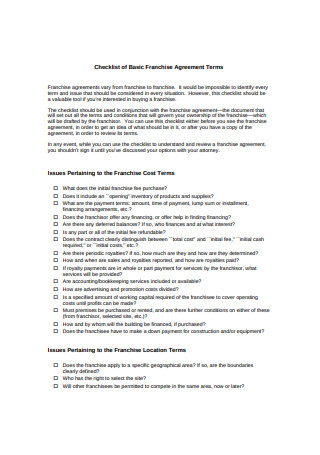
Basic Franchise Agreement Checklist
download now -

Cable Television System Franchise Agreement
download now -
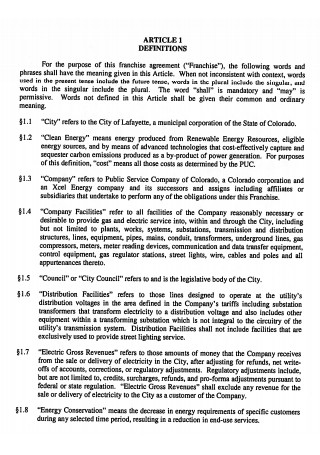
New Franchise Agreement
download now -
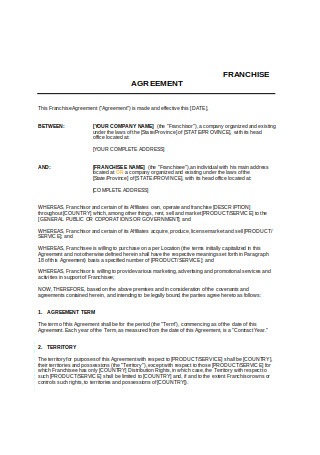
Company Franchise Agreement
download now -
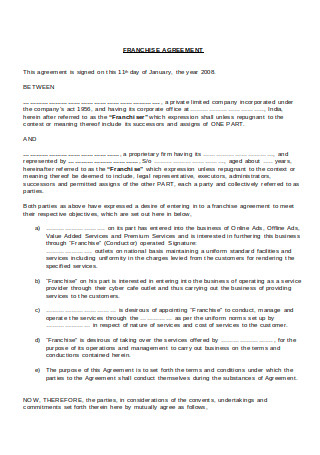
Standard Franchise Agreement Sample
download now -
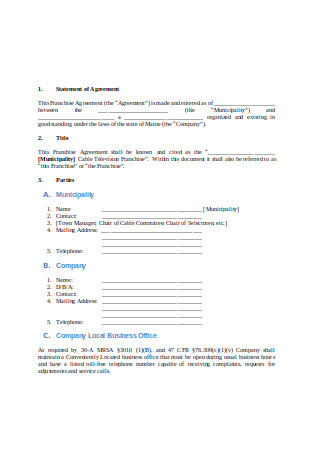
Printable Franchise Agreement Sample
download now
What is a Franchise Agreement?
An efficient business expansion method is franchising. Most companies choose to accept franchisees to establish their brand in other parts of the country and in the world. In this particular business relationship, a franchise agreement is needed to lay out the guidelines of the agreement. The relationship of each party, franchisor and franchisee, are specifically phrased in this document. The franchisor is the owner of the brand. They own and trademarked the brand and its operating system. On the other hand, the franchisee is an independent contractor that wants to expand and operate the brand in a specific area. The obligations of each party are also specifically spelled out in the agreement. The franchisor takes on the role of providing the brand name, operating system, management training, established marketing strategies, and full-on support from the head office. As the franchisee receives all these resources, their role is mainly the daily operations of the franchise and to uphold it according to the established quality standards.
Having a legally binding franchise agreement protects both the franchisor and franchisee, who can also be labeled as licensor and licensee. As the brand name is the most valuable asset in this type of agreement, the contract protects it as the intellectual property of the licensor. It also protects the operating system of the company, which is essentially how they do their business. It includes their business plans and strategies. Apart from protecting the IP, the agreement also protects the reputation of the organization. There are stipulations in the contract that serve as guidelines on how the business should be to improve the reputation and boost the marketability of the business in the area. It is based on the assumption that the performance of one franchise affects the entire brand.
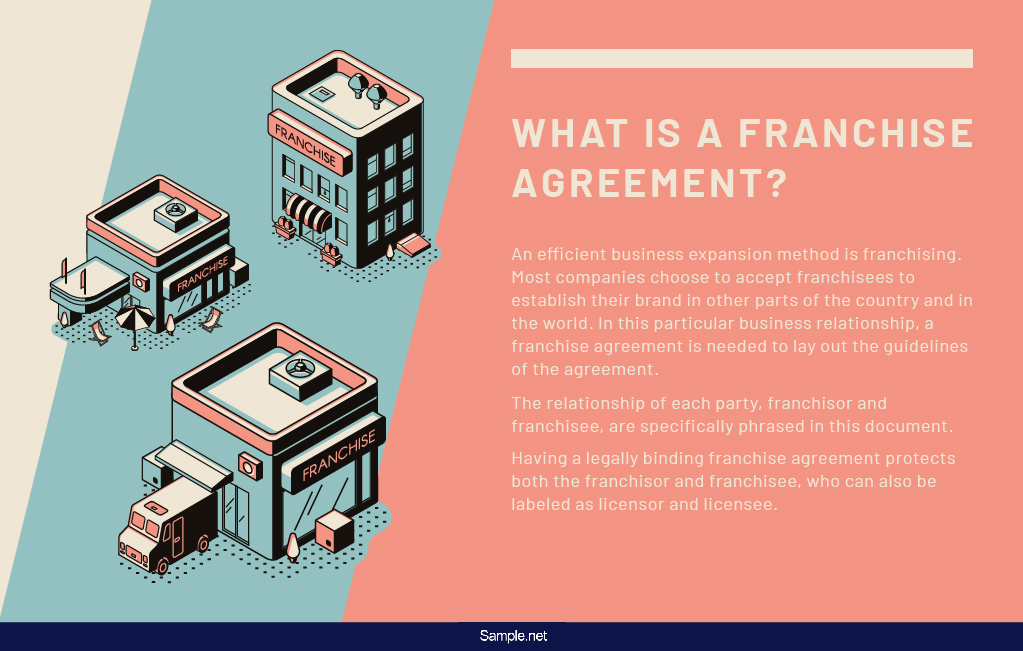
Elements of a Franchise Agreement
How to Make a Franchise Agreement
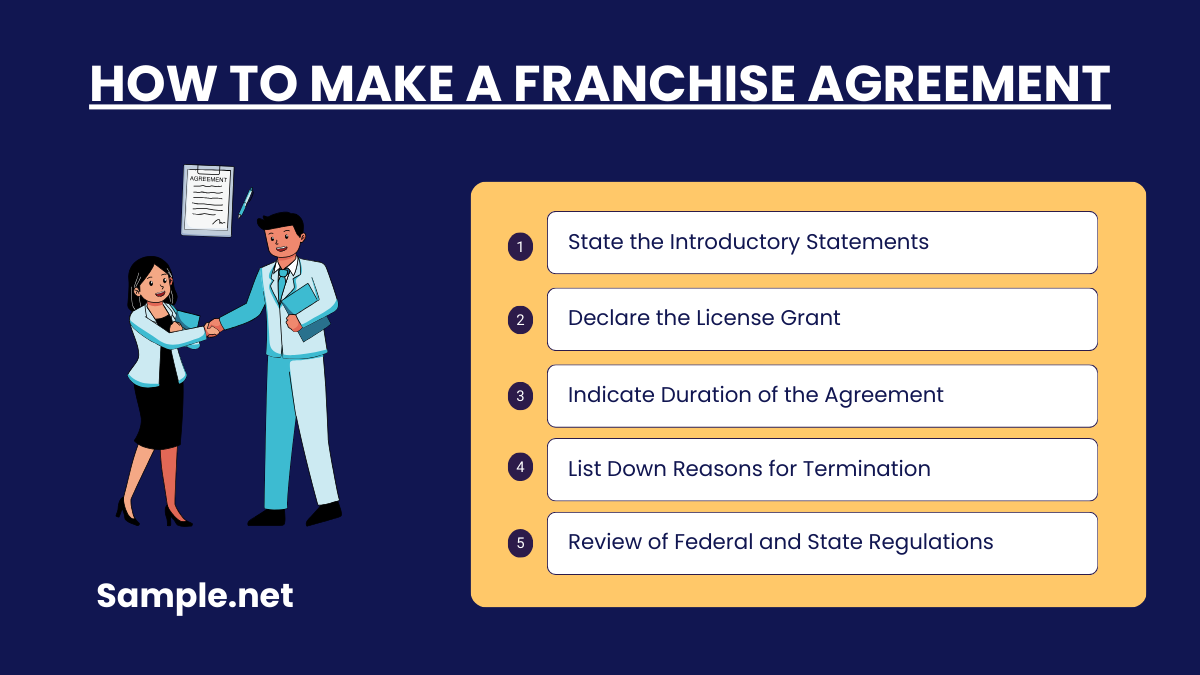
It comes to no surprise that most franchise agreements greatly favors the franchisor. It is only plausible because franchisee rides on the established reputation and operating system of the business. As a franchisee, even if your party will not significantly contribute to the drafting of the contract, it is ideal to know the process to know what to look out and demand for in an agreement. On the franchisor’s perpective, they want to sustain and uphold the reputation that they built over the course of years. So, it is also natural that the contract comes close to a rule book in presenting what the franchisee must and can do for the business to thrive. You can also see more on Corporate Agreement.
Step 1: State the Introductory Statements
The introductory statements are the whereas statements that begin any agreement or contract. For a franchise agreement, it introduces and highlights the value of the brand. It describes the nature of the business and the role it plays in the industry. The build-up of the brand also doubles as a justification for its licensing rate. Utilizing a basic theory in Economics, a significant amount is justifiable for things with high demand and value. In the agreement, it also identifies the roles of the parties, points out which is the franchisor and which is the franchisee.
Step 2:Declare the License Grant
There should be stipulations in the contract that directly express consent to use the trademarks of the franchisor in exchange for paying the licensing fee. In this sense, the licensing and royalty fees are also introduced in this part of the contract. Most companies compute for their royalty fee based on the monthly gross income of the franchise. They take a particular percentage from the amount. Most franchise agreements are also nonexclusive in nature. This arrangement means that the franchisor can engage in several franchise agreements at the same time. Naturally, businesses opt for this arrangement because franchising aims to widen its market.
This part of the contract also states limitations. You can choose to include specific stipulations on how the other party can use the trademarks, such as the logo, brand statements, and business colors. Some companies are very strict in their uniformity across all the stores in the franchise system. Other companies also impose the territory of a new branch, mainly to avoid competition within the company. Important dates are also presented in this part of the agreement. The start date of the agreement and when it should open and start operations. You can also see more on Dealership Contract.
Step 3: Indicate Duration of the Agreement
A standard franchise agreement runs for ten to twenty years on average. In this span, there are several key dates to take note of. Aside from remembering the dates for tax filing, payment due dates are essential to remember. In these agreements, the franchisee has monthly payment dues to the franchisor for its continued use of its business trademarks. On the flip side, the end date of the agreement is also already noted. For agreements as long-lasting as this, notices for renewals are sent several months before the end date of the business contract. This document notifies the franchisee to start thinking about continuing the contract for the next years. Renewing has a corresponding renewal fee and the branch must pass the standards set for eligibility.
In some cases, the franchisor demands the franchisee to start operations on a particular date, but this can also depend on the location of the branch. The starting date of operations may also be considered as the start of the agreement. Some companies adhere to this agreement, seeing that this arrangement is more beneficial for them. You can also see more on Royalty Agreement.
Step 4: List Down Reasons for Termination
An agreement may end because of several legal reasons. First and foremost, the franchisee may choose not to renew the partnership. The franchise relationship may also be terminated because of the bankruptcy of either of the party. The franchisor can no longer sustain the business and need to cut some expenses or the franchisee is no longer capable of paying the monthly fees because of little or no revenue. The agreement can also be cut short when either of the parties committed a crime or fraudulent activity. Clauses regarding termination because of criminal activity can also be included as part of dispute resolution. Furthermore, it is also impossible to continue with the partnership if the franchisor loses its trademark on its branding due to dispute, which went under proper litigation processes.
Step 5: Review of Federal and State Regulations
It is important to review related documents, federal, and state regulations in coming up with the agreement to make sure that the terms are legal, binding, and executable. One thing is to review the definition of a franchise according to the Federal Trade Act. Upon its signing, its main purpose is to ban unfair practices that affect activities in commerce. The act provided several factors that define a franchise. However, the factors provided in the Federal Trade Act serve as guides, there are states which have more stringent defining factors of what a franchise is. Moreover, some states also require additional requirements and processes such as franchise registrations. So, before finalizing your franchise agreements, make sure that all the clauses and stipulations are enforceable in your state. It is also a best practice to consult with an experienced business lawyer who focuses on franchise agreements. This additional step will only help you make sure that the agreement protects the interests of both parties, and at the same time, demand more or less equal efforts from both. You can also see more on Restaurant Contracts.
FAQS
What happens if a franchisee breaches the agreement?
If a franchisee breaches the agreement, the franchisor can take actions such as issuing warnings, imposing penalties, or terminating the contract. The agreement usually outlines the procedures for handling breaches, ensuring both parties have clarity. Termination can include reclaiming the franchise location and revoking rights to use branding or intellectual property.
How does a Franchise Agreement protect intellectual property?
The agreement includes clauses restricting the unauthorized use of trademarks, logos, and proprietary methods. It ensures the franchisee uses these assets strictly for operating the franchise. It also prevents the franchisee from sharing or copying the franchisor’s trade secrets. This protection is critical to maintaining the brand’s uniqueness and value. You can also see more on Service Supplier Agreement.
What are the key financial obligations in a Franchise Agreement?
Financial obligations include the initial franchise fee, royalty payments, marketing fund contributions, and other operational costs. These terms are clearly outlined in the agreement, along with payment schedules. Failure to meet financial commitments can result in penalties or contract termination, ensuring accountability.
What should a franchisee review before signing the agreement?
A franchisee should carefully review terms like fees, territorial rights, operational standards, and termination clauses. It’s advisable to seek legal counsel to understand implications and negotiate terms if needed. Reviewing renewal terms, intellectual property usage, and conflict resolution mechanisms is equally important. A thorough review prevents future disputes.
What is territorial exclusivity in a Franchise Agreement?
Territorial exclusivity means the franchisee is granted the sole right to operate within a specific area. The agreement defines the territory and prohibits the franchisor from opening competing units there. This protects the franchisee’s business potential and market share. You can also see more on License Agreements.
